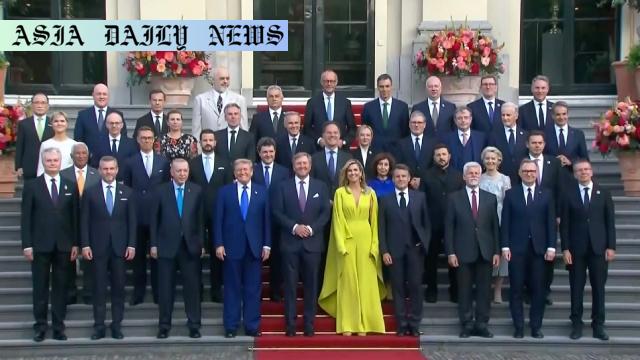NATO Summit – Leaders of NATO member countries gathered in the Netherlands for a summit to discuss increasing defense spending.

NATO Summit Begins with High-Profile Attendance
The NATO summit commenced in The Hague, Netherlands, bringing together leaders from across the alliance in a demonstration of their unity against global security challenges. Hosted in the regal setting with King Willem-Alexander presiding over the initial banquet, this meeting highlights NATO’s dedication to modernizing its defensive strategies. Among the prominent attendees were US President Donald Trump and Ukrainian President Volodymyr Zelenskyy, whose presence underscored NATO’s unwavering support for Ukraine as it faces ongoing conflict.
President Trump, long critical of the alliance’s current funding policies, reiterated his stance that NATO allies must contribute more substantially to their collective defense. This year’s agenda includes an ambitious proposal for member countries to raise their defense spending to 5% of GDP, a significant leap from the earlier benchmark of 2%. Trump’s strict criticisms reflect his push for equitable distribution of defense responsibilities across all NATO members. The summit is seen as a pivotal occasion to reaffirm NATO’s commitment to tackling both traditional and emerging threats to global security.
A Pivotal Funding Proposal to Meet Modern Challenges
The proposed increase in defense spending has drawn global attention, as it represents a marked shift in how NATO operates financially and strategically. Historically reliant on the US as its principal contributor, the alliance is increasingly being urged to adopt a more equitable approach. By pushing for the adoption of a 5% GDP defense spending goal, this summit signals a bold intent to position NATO as a more balanced and unified security alliance.
While the idea garners strong support from some nations, the challenge lies in ensuring that all members can commit to and deliver on this ambitious financial target. Given the ongoing geopolitical instability in regions like the Middle East and Eastern Europe, strengthening collective defense mechanisms is deemed paramount. However, implementing higher expenditure levels will require member states to reevaluate their domestic budgets, potentially reallocating funds away from other key areas like healthcare and education.
Solidarity with Ukraine: A Key Theme
Ukrainian President Volodymyr Zelenskyy’s presence at the summit underscores NATO’s ongoing support for Ukraine amid its conflict with Russia. Zelenskyy’s participation is symbolic of the alliance’s broader strategy to project unity and resistance against any forces that threaten democratic values. The discussions around Ukraine are expected to focus on military aid, intelligence sharing, and the potential acceleration of its NATO membership application.
For NATO, solidifying its partnership with Ukraine is not only a geopolitical necessity but also a statement of intent to counter aggression and expand democratic stability in Eastern Europe. Such moves further emphasize the alliance’s efforts to deter potential adversaries and uphold international peace and security standards, despite the increasing complexity of global conflicts.
Geopolitical Implications of Increased Defense Spending
A key backdrop to the summit discussions is the current state of Middle Eastern politics and other volatile areas. With escalating tensions and uncertainties in regions such as Iran and Syria, NATO’s member states are under pressure to present a unified and robust defense posture. By committing to increased defense spending, the alliance seeks to reinforce its readiness to effectively manage crises and respond to unforeseen challenges.
Observers note that this emphasis on increased expenditure also serves as a warning signal to global adversaries. It signifies NATO’s determination to remain relevant and adaptive in an environment of rapidly evolving threats, from cyber warfare to territorial disputes. Going forward, it will be critical to strike a balance between increased spending and the efficient allocation of resources to ensure optimal impact across all priority areas.
Commentary
The Importance of the NATO Summit in Today’s Context
The NATO summit represents a critical opportunity for member nations to reflect on their shared values and responsibilities. In an era defined by complex and interconnected security threats, from hybrid warfare to cyberattacks, this meeting is a reminder of the importance of collaboration. By proposing a 5% GDP defense spending benchmark, the alliance is making a concrete statement about its readiness to address these challenges head-on.
However, this proposal is not without its difficulties. Achieving such an ambitious target will require comprehensive planning and significant trade-offs. Each member state will have to weigh the costs against the benefits, rethinking their spending priorities to align with broader collective goals. While this might strain some economies, the ultimate aim is to ensure a more balanced and sustainable system where the burden does not disproportionately fall on the United States.
Solidarity with Ukraine: A Moral and Strategic Imperative
The inclusion of Ukrainian President Volodymyr Zelenskyy at the summit adds a layer of poignancy and urgency to the proceedings. Ukraine’s struggle against external aggression is not merely a regional issue but a litmus test for the commitment of NATO and its allies to democratic ideals. Strengthening support for Ukraine sends a resolute message that principles of sovereignty and territorial integrity will not be compromised.
The meeting also serves as an opportunity for NATO to delineate its broader strategy for addressing issues in Eastern Europe. From military assistance to membership discussions, there is a need to demonstrate tangible support for Ukraine amidst its ongoing struggles. At the same time, NATO must consider the broader implications of its decisions, ensuring they contribute to long-term stability rather than escalating existing tensions.


